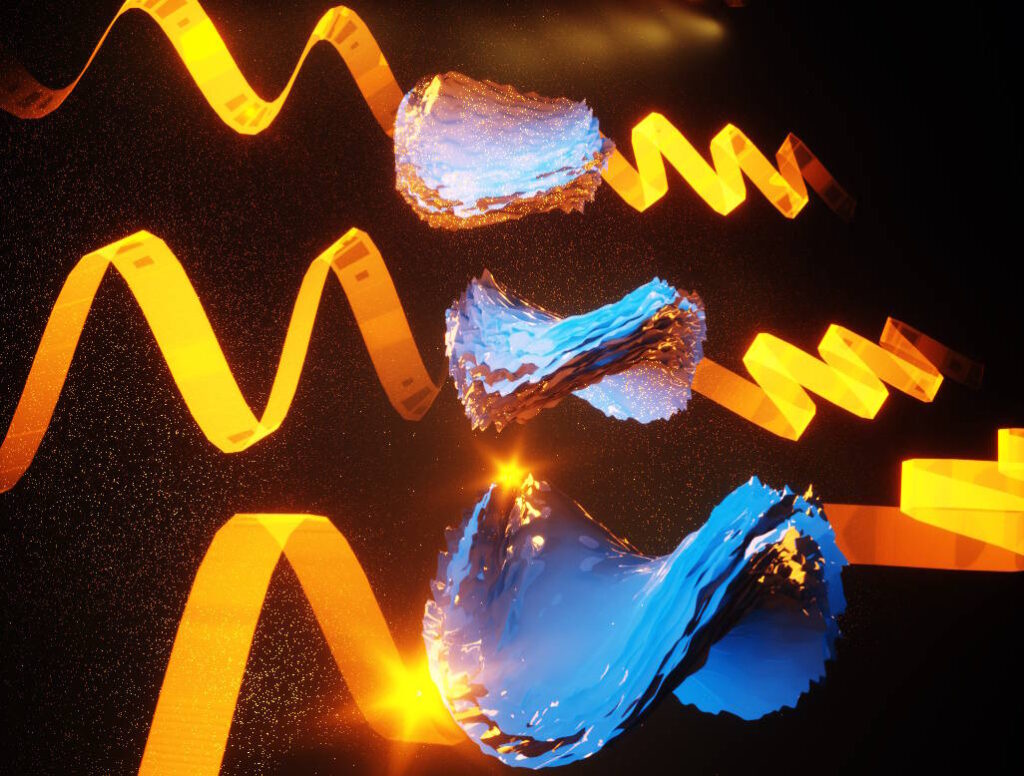Researchers at the University of Michigan in the US have created bowtie-shaped nanostructured microparticles whose chirality, or handedness, can be tuned continuously over a wide range. The complex particles, which are constructed from simple components that are sensitive to polarized light, form a variety of curling shapes that can be precisely controlled. The photonically active nanoassemblies might find use in a host of applications, including light detection and ranging (LiDAR) devices, medicine and machine vision.
In mathematical terms, chirality is a geometric property, described by continuous mathematical functions that can be pictured as the gradual twisting of a sweet wrapper. A family of stable structures with similar shapes and progressively tuneable chirality should therefore be theoretically possible. In chemistry, however, chirality is often treated as a binary characteristic, with molecules coming in two versions called enantiomers, which are mirror images of each other – much like a pair of human hands. This chirality is often “locked in” and any attempt to modify it results in breaking the structure.
Continuous chirality
A team of researchers led by Nicholas Kotov has now shown that nanostructures with an anisotropic bowtie shape have continuous chirality, meaning that that they can be fabricated with a twist angle, pitch width, thickness and length that can be tuned over a wide range. Indeed, the twist can be controlled all the way from a fully twisted left-handed structure to a flat pancake and then to a fully twisted right-handed structure.
The bowties are made by mixing cadmium and cysteine, a protein fragment that comes in left- and right-handed varieties, and then suspending this mix in an aqueous solution. This reaction produces nanosheets that self-assemble into ribbons that then then self-stack on top of each other, forming the bowtie-shaped nanoparticles. The nanoribbons are assembled from nanoplatelets 50–200 nm in length with a thickness of roughly 1.2 nm
“Importantly, the size of the particles is self-restricted by the electrostatic interactions between the nanosheets and the particles overall,” explains Kotov, “a mechanism that we discovered in a previous study on supraparticles and layered nanocomposites.”
If the cysteine is all left-handed, left-handed bowties form and if it is right-handed, right-handed ones form. If the mix contains different ratios of left- and right-handed cysteine, however, structures with intermediate twists can be created. The pitch of the tightest bowties (that is, those with a 360° turn over their entire length), is about 4 µm.
The researchers found that the nanostructures reflected circularly polarized light (which propagates though space in a corkscrew-shape) only when the twist in the light matched the twist in the bowtie shape.
5000 different shapes
The team succeeded in producing 5000 different shapes within the bowtie spectrum and studied them in atomic detail using X-ray diffraction, electron diffraction and electron microscopy at the Argonne National Laboratory. Scanning electron microscopy (SEM) images show that bowties are structured as a stack of twisted nanoribbons 200–1200 nm in length and 45 nm thick.
The reasons for continuum chirality come thanks to the intrinsic properties of the nanoscale building blocks. First, flexible hydrogen bonds allow for variable bond angles, explain Kotov and colleagues. Second, the ability of nanoribbons to ionize leads to long-range repulsive interactions between nanoscale building blocks that can be tuned over a wide range by changing the pH and ionic strength. And since the nanoribbons twist, the total electrostatic potential becomes chiral, which reinforces the handedness of the assemblies.
“Compared to the ‘simple’ supraparticles we studied in our earlier work, the ones made from chiral nanoclusters can form more complex structures,” Kotov tells Physics World. “Controlling their electrostatic interactions enables us to vary their size and shape. Establishing such a chirality continuum for synthetic chemical systems, such as these complex particles, allows us to engineer their properties.”
The researchers, who report their work in Nature, say they are now busy looking into applications for their bowtie particles in machine vision. “Circularly polarized light is rare in nature and thus very attractive for such vision since it allows one to cut out noise,” explains Kotov. “The engineered bowtie structures could also be used in capacity as markers for LiDAR and polarization cameras.”
The twisted nanoparticles may also help create the right conditions for producing chiral medicines. Chirality is an important property of drugs, as enantiomers of the same molecule can have entirely different chemical and biological properties. Distinguishing between them is thus particularly of interest to those developing new pharmaceuticals.


